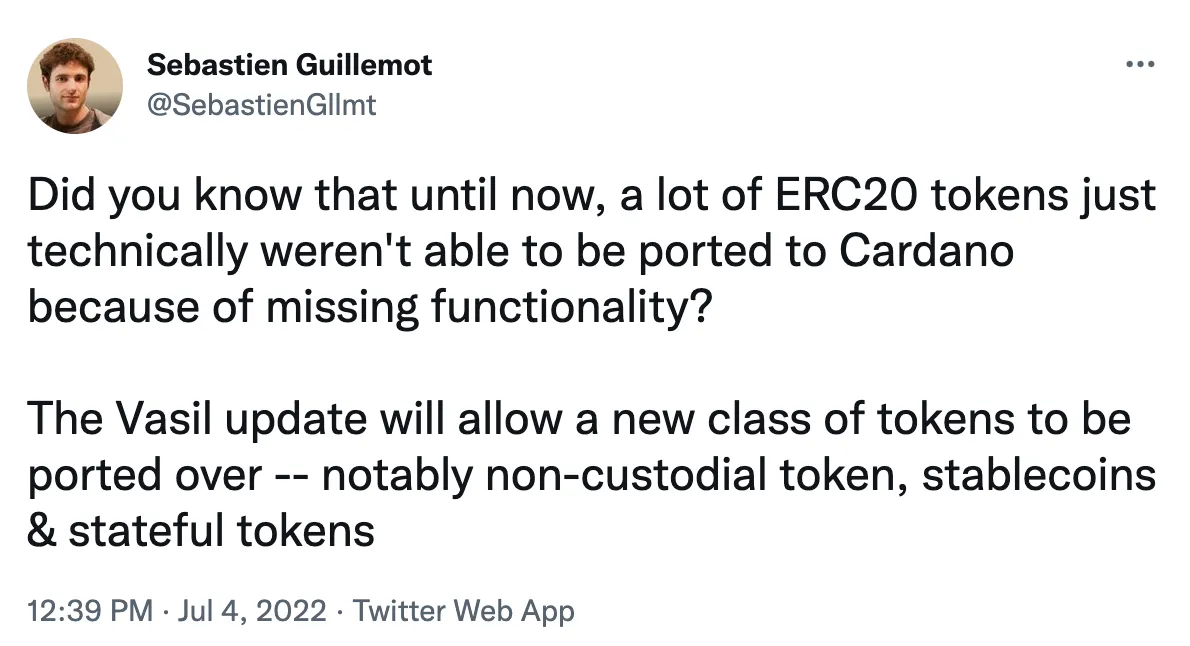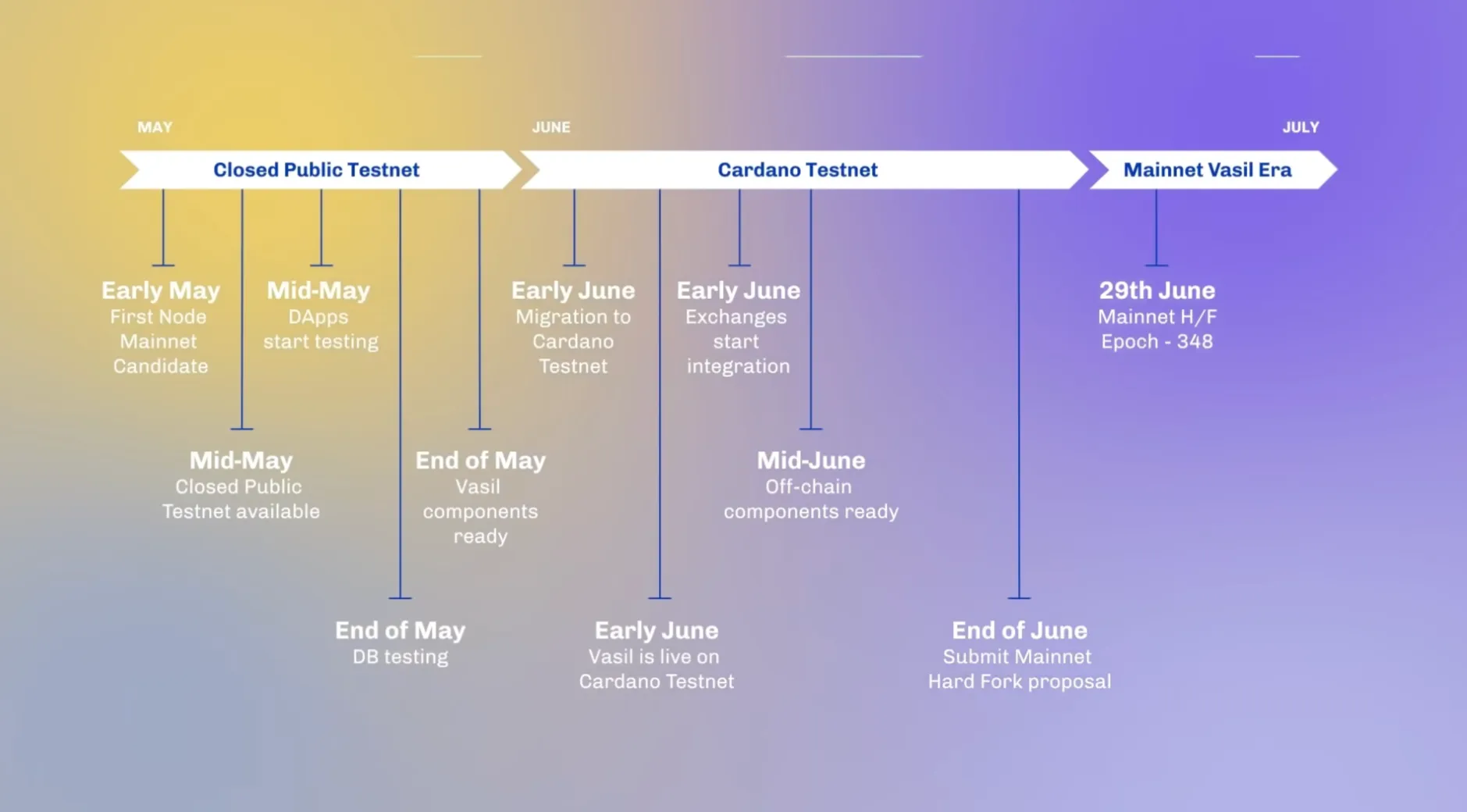Cardano's Vasil hard fork cruises ahead successfully
Vasil hard fork, was successfully completed on September 22nd. When Vasil merged some upgrades did not immediately active; those features will be activated on September 27th i.e at the lapse of the current epoch. Combined, these upgrades will enable Cardano increase transaction throughput.
The Vasil merge was an automated process that become inevitable after the following milestones were met.
- At least 80% of exchange partners updated to node version 1.35.3
- At least 75% of Cardano stakepools updated their nodes to version 1.35.3
The top 10 dApp developers their updated their smart contracts to be compatible with the latest node i.e 1.35.3.
Now that Vasil's upgrades are available on Cardano's mainnet, projects like Djed, Ardana, LiqWid Finance among other dozen projects can launch. Other projects e.g Wingriders, MuesliSwap have already angled themselves to to fine tune their service using this upgrade.
On the Milkomeda C1 sidechain, Vasil will help move non-custodial tokens, stablecoins and stateful tokens from EVM chains. These class of ERC-20 assets were technically impossible to bridge over to Cardano before.
As a result, this hardfork will boost transaction volume and TVL on the Cardano main chain and its first EVM sidechain.

The Vasil update was named after the late Vasil Dabov, who was a Cardano Ambassador, a Haskell programmer, and an environmental conservatist (ginkgologist). According to IOG, Vasil hardfork is the most complex upgrade the team has worked on to date.
Other projects e.g Cornocupias are hoping that the improved throughput will help ease the congestion caused while minting NFTs on the Cardano chain.

Which updates will Vasil hard fork bring?
Vasil HFC brings scaling solutions that include diffusion pipelining & updates to Plutus, Cardano's smart contract platform. These changes will result in an improved developer experience among Cardano's dApps teams.
The update has also permanently set Cardano's d parameter to zero (0). Essentially, this change will ensure that all future block generation will be decentralized. Cardano stake pools will be fully in charge of this block generation process.
Ouroboros' Verifiable Random Function (VRF) will also be optimized via Vasil upgrade. Pre-Vasil, two VRF functions were called during every network hop for block validation to pass. Post-Vasil, only one of these functions will be used. This optimization will benefit the users with faster block validation and sync times.
This upgrade to the Ouroboros protocol maintains prevailing security guarantees.
Cardano improvement proposals (CIPs)
| CIP | Function | Benefit(s) |
|---|---|---|
| CIP-31 | Reference inputs | improves cardano concurrency |
| CIP-32 | Inline datums | improve parallelism |
| CIP-33 | Reference inputs | smaller, cheaper & faster transactions |
| CIP-40 | Collateral outputs | eliminate risk of losing collateral |
CIP-31
This improvement will enable developers to read UTXO without using it and recreating it.
CIP-32
Unlike before, developers will have the ability to store their data on-chain after this, helping decentralization
CIP-33
Developers to store their app logic on-chain. As part of this update, Plutus will be a lot faster. Plutus scripts will be 20% smaller, its interpreter will be 40% faster and non-evaluation processing will be 80% faster.
CIP-40
Transactions will charge collateral that's just enough to cover the requirements of the contract. Any excess amounts will be returned to the user.
For an in-depth illustration of the changes coming to Plutus, please watch this technical video by John Woods, IOG's Cardano architecture director
Diffussion Pipelining
This update will help make Cardano block propagation faster while retaining the network's security checks.
The goal here is to reduce the latency that occurs when blocks wait to fully validate a block before it's propagated. Blocks can now be propagated on the network within 5 seconds of their creation.
Did Vasil HFC include Hydra?
No, Hydra was not be part of the Vasil hard fork. Hydra is a layer 2 scaling solution that will launch on Cardano's mainnet in 2023. As a horizontal scaling solution, it will share the same security protections with the mainnet. Unlike Ethereum's layer 2 solutions, Hydra will not need a separate token.
Preparations after Vasil hard fork
A recent team status update states that the consensus and node teams have been prepping the Ouroboros consensus algorithm for the upcoming hard fork.
The teams have also worked on improving the performance of UTXO HD (description of how the Cardano blockchain is stored), testing diffusion pipelining, and benchmarking. In addition, Cardano has increased its block size by 10% to further increase the network's speed.
The closed public testnet is now open to a curated selection of dApps.
Cardano price expectations
According to John woods, it's going to take one Cardano epoch for the CIP changes to take effect after the hard fork event.
Developers will need to change the architecture of their codebases to take advantage of the benefits brought in by the Vasil update.
Considering these facts, the price of ADA is likely to see a little pump leading up to the Vasil hardfork. However, that price action will mostly likely be modest given that we're currently in what looks like a bear market. In the long run, the benefits that Vasil update will bring to Cardano will lead to an explosion of Cardano's ecosystem. This growth is the recipe needed for a sustained uptick in ADA price.
Other than scaling, Cardano's ecosystem is in need of a native stablecoin. Pre Vasil, liquidity providers are using ETH-bridged stablecoins e.g madUSDT and madUSDC to cushion themselves from the volatility that often results in impermanent loss.
Djed, a Cardano-based stablecoin, is scheduled to launch along the Vasil hard fork or shortly after. This overcollateralized algorithmic stablecoin will help ADA holders provide liquidity into other Cardano projects with confidence, hence boosting TVL and the overall growth of Cardano.
Why Vasil hardfork was earlier delayed
In a youtube video session, Charles Hoskinson confirmed that the Vasilmhardfork date has been moved from June 29th to the last week of July.
This date has further been pushed further into the future. The HFC event will occur after several weeks, probably in August or September.
Even though the update was code complete at the time, the Cardano team made the decision to delay because:
- There wanted more time to fix a few non-critical bugs that came up
- Do more unit and end-to-end testing
- Give dApp developers more time to test their dApps on the testnet
- Allow exchanges and other partners more time to prepare for the update
Vasil testnet countdown updates
IoHK announced the following updates via twitter.
- Over 75% of testnet blocks are now created by the new Vasil node (1.35.0), providing the Cardano team good chain density to proceed safely.
- Since the changes took effect after the start of epoch 215 at 20:20 UTC on 3 July, the #Cardano testnet started to enjoy the new #Vasil enhancements and capabilities that will soon be on mainnet.
- The community requested a minimum period of 4 weeks to allow SPOs, devs & exchanges the time they need to test and upgrade before hard forking the #Cardano mainnet. Once everyone is comfortable & ready, Cardano's team will go through the same process to upgrade the mainnet to #Vasil.
More details about the Vasil hard fork will be revealed during July's mid-month Cardano 360.
Vasil hardfork upgrade scheduled for September 22
According to a tweet made on September 2nd by Cardano creator and operator Input Output Global (IOG), Vasil, the hardfork upgrade for the Cardano blockchain, will go live on the mainnet on September 22.
Plutus, Cardano's smart contract platform, will receive improvements as part of the upgrade, enabling programmers to build more potent and effective blockchain-based apps. The announcement came a day after commission-free stock and cryptocurrency trading service Robinhood said in a tweet that Cardano (ADA) had been listed as a result of several user requests. Although users can purchase and sell ADA, Robinhood does not yet offer a transfer option.
The upgrade was originally supposed to happen in June, but a number of technical issues made that impossible. According to claims, this release is the biggest and most significant in Cardano's history. IOG anticipates the fork to go off without a hitch, though.
The Cardano community is now more bullish on Cardano as a result of the listing of Cardano (ADA) just before the eagerly anticipated Vasil hard fork.
First published on May 6, 2022
Cardano